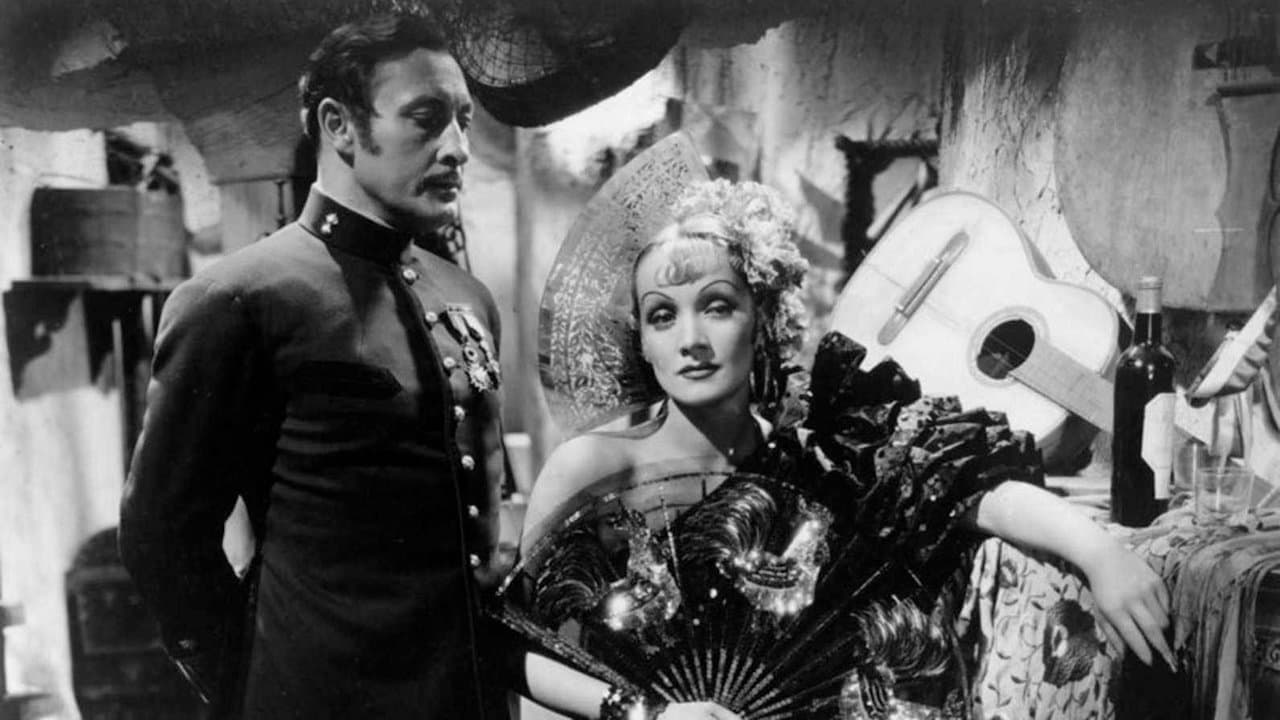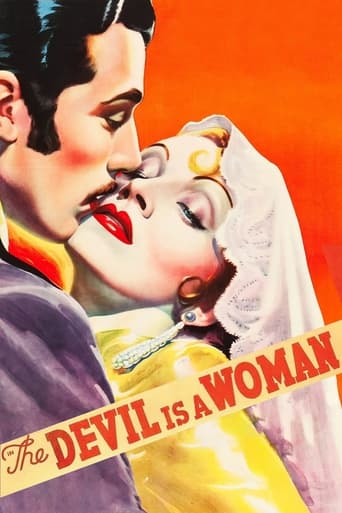Matialth
Good concept, poorly executed.
SparkMore
n my opinion it was a great movie with some interesting elements, even though having some plot holes and the ending probably was just too messy and crammed together, but still fun to watch and not your casual movie that is similar to all other ones.
Ezmae Chang
This is a small, humorous movie in some ways, but it has a huge heart. What a nice experience.
Delight
Yes, absolutely, there is fun to be had, as well as many, many things to go boom, all amid an atmospheric urban jungle.
talisencrw
Very few aesthetic delights of the post-Code era tantalize and linger long afterwards in the mind as much as films from the Marlene Dietrich/Josef Von Sternberg partnership, and this, thankfully kept in Dietrich's vault as it was the favourite of her films, is no exception. Though anyone who knows me will readily recall I prefer the twice-Oscar nominated (for 'Morocco' and 'Shanghai Express'), Viennese expert craftsman's silent pictures to those made with the sexpot, this saga of vengeance is also superlative and well worth both purchasing and re-watching. Paramount caved in to pressure by the Spanish government, who hated the way Pierre Louÿs' novel portrayed the Spanish police, and actually destroyed the original print. Thankfully Dietrich's fear that her favourite film would otherwise be lost meant it was extremely well-preserved, and I saw my copy as part of a superlative DVD boxed set of six of her films that I've had for a few years now.
Steffi_P
This was the last of the eight Sternberg-Dietrich collaborations and, like their off-screen relationship, their on screen partnership was by now turning a little sour. It shows.One thing that sets the Devil is a Woman apart from the pictures that preceded it is that von Sternberg seems less keen to show off Marlene's beauty. Whereas in the Blue Angel, Morocco or indeed any of the others he would use scintillating light patterns to give her face an other-worldly glow – something he would never treat the other actors to – she is now like the rest of the cast shot as if she were part of the set. Also, Dietrich's interpretation of her character is rather dull; all pouting and melodramatics, a far cry from the assured performances she gave in Morocco and Scarlet Empress. This is particularly significant for this of all pictures. For the story to work, Marlene needs to appear seductive to the audience, so we can see what the attraction is for her lovers. As it is her portrayal is unsympathetic and uninteresting, making it considerably less credible for men to be shooting each other for her attention.Aside from that there is little else going on here. The story is a loose knock-off of Carmen. Sternberg's visual constructions are pretty as always, and with the carnival setting he really gets to have fun with trailing streamers and garish masks, although the metaphor of Concha as a spider, with the streamers her web is perhaps stretched a little thin. As with the Scarlet Empress there is an attempt to choreograph the action to famous pieces of classical music, in this case Rimsky-Korsakov's Capriccio Espagnol, but it is not particularly well-developed.There are however a few treats on the acting front. Lionel Atwill is particularly good. Atwill was one of those rare character actors who would normally deliver an over-the-top supporting performance, and yet was fully capable of reining things in a bit when cast in a more serious dramatic role. And yet he still retains that "character actor" sparkle, that actually makes good comedy of lines like "A most outstanding pleasure…" In fact one of the strong points of the Devil is a Woman is that, through its cast, it manages to make comic relief out of serious moments. For example the casting of Edward Everett Horton (probably best known as Fred Astaire's sidekick) as an authority figure might seem ill-advised, but when he too confesses an obsession with Concha the scene plays for laughs. Don Alvarado is also great in an almost mute – and consequently funny – role. It's just as well these supporting players are good, as the second lead man Cesar Romero unfortunately delivers a leaden lump of a performance.It seems that with their personal and professional relationships on the way out, both Dietrich and von Sternberg were simply going through the motions on this one (although strangely Dietrich named this as her favourite of her films). Of course some might say that even a half-arsed effort from a great director and a screen icon should be pretty good, but coming after the magnificent Scarlet Empress (the one Dietrich-Sternberg film that really works) this is something of a disappointment.
satranc12
After having watched The Devil is a Woman innumerable times, I still can't get over my excitement about certain scenes: If you haven't seen the film yet, go for it. If you know it well, re-live the pleasure of it reading these lines.1. Above all: The scene introducing Concha in midst of the carnival crowds and carriages. Her entrance is carefully prepared: First we are we get a glimpse of a somewhat faded Senora flirting from a balcony. The music meanwhile is a cacophony of brash carnival tunes, the images likewise chaotic montage, the screen filled with crowds, balloons, streamers and confetti, the sound and images seem to be cropped and assembled at random.The cacophonic music suddenly changes to trumpet fanfares which announce the arrival of Concha's carriage. The camera pans down from a balcony to the street, following downward hanging white streamers. Concha's white carriage enters from the left, drawn by a pair of white horses, two coachmen in white livery. She is sitting all alone in an ocean of white and presumably pink balloons, wearing her famous black pompom costume with matching head-dress, black lace mask and black lace gloves, underneath nails painted very red, as you can later see when she shakes her finger at Antonio. She's holding to her bosom a huge mass of white carnations which she throws to the admiring crowds. Meanwhile in the foreground, entering from the right, three black carriages drive by, drawn by dark horses, inside several young women who judging by their costumes and behavior obviously haven't Concha's class. The whole scene drowned streamers, balloons, confetti.If this alone doesn't make you hair raise, there is the most erotic, flattering and slightly risqué "Spanish dance music" accompanying Concha's flirtations and close-ups. No harsh carnival tunes for her! The scene is so rich, it must be seen (and heard) many times.2. Another scene which gains immensely by the music. It's not Rimski or Falla, Sternberg must have dug up a lot of traditional Spanish music which I can't identify being no expert, sorry. Concha has just seduced Antonio to accompany her to her box in a ballroom where they are supposed to have a sort of farewell over a cup of coffee. They arrive in the dark in front of the entrance. A servant opens the door which is really just a wooden latticed frame. Concha precedes and mounts a staircase. The camera stays outside in the dark. Her whole climb is visible from the outside, the stairs again being separated from the outside only by very sparse wooden frames painted white. Concha wears her white fringe dress and mantilla and mounts the stairs before Antonio, holding her fan in her right hand, parting the streamers with it while passing through, and spreading her left elbow extremely outwards. I suppose this is the way coquette Spanish women mount stairs. She looks behind exactly four times to make sure Antonio is following. She passes on her way a huge brightly lit painting (another painting, of a bull, hangs just outside Concha's box, but that comes later) and halfway meets another carnival crowd running downstairs. Inside her box she pops a few more balloons with a revolver.Meanwhile the music, which had been Rimski during the scene in the "avenue of the Sycamores", changes again to a wonderful erotic rhythmic piece to the tune of which Concha climbs the stairs and shoots the balloons.3. The whole film is full of such marvels, enjoy.
netwallah
A sadly predictable, clichéd story about a woman who was no better than she should have been. Sadly, too, the screenplay is by the once-great experimental novelist John Dos Passos, from an original by French exotic potboiler Pierre Louys. This time Marlene Dietrich is Concha, a manipulative, cold-hearted Spanish beauty. Don Pasqual (Lionel Atwill) raises her from the cigarette factory, but she ditches him. He warns his tall young friend Antonio (Cesar Romero) against her, but to no avail. A duel ensues, Concha reproaches Pasqualito for trying to kill the only man she ever cared for, so he doesn't: he points his pistol at the sky, but Antonio shoots him. But instead of going off to Paris with the young victor, she goes back to the man who would have died for her. With an unexpected bit by Edward Everett Horton as a Spanish Governor. Dietrich plays the part of a Spanish woman by moving constantly, twisting at the waist and posturing and then twisting back, flouncing, tossing her head, and so forth. And she makes faces, and has a curl in the middle of her forehead. The photography is strangely crowded: no outdoor scene can be shot except through a tangle of bare trees, no interior scene can be shot without so much busy detail that it's almost impossible to follow people moving across a room, no consecutive scene of Dietrich can be shot without a major wardrobe change. The carnival scenes are so full of confetti and streamers it's almost like an underwater scene in the Sargasso Sea.

